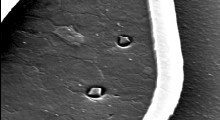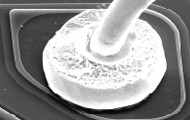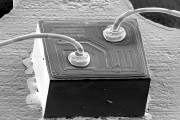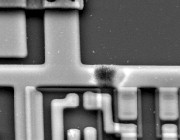ESD (Electro Static Discharge) and Thee
Before we begin to discuss ESD and the subsequent problems it can cause, this brief guide to ESD is intended for the home computer enthusiast. We will not delve into how ESD effects industry, or large scale manufacturing of sophisticated electronic devices. The focus will be on people who enjoy building their own home computer systems. There have been countless pages written on ESD, the resulting damage from ESD, and entire industries and businesses built around ESD. There are also several Military Standards Specifications, Engineering Standards and Specifications and NIST (National Institute of Standards and Technology) standards for ESD. Simply put, there is no shortage of material out there for ESD. Our only concern is how it affects us, the home computer enthusiast who enjoys building his or her own systems.
So what exactly is ESD and why is considered such a "Bad Thing"? Static Electricity is just what its name implies, it is electricity that is static as in not going anywhere or really doing anything. Actually if we think about it, static electricity is in itself relatively harmless. The problem is the "D" part as in discharge. That is what causes things to really turn bad. We have all experienced static electricity and the discharge of static electricity. The classic example is walking across a carpet and reaching for a metallic doorknob. This results in a small crack sound and if it is dark enough we see a blue arc of electricity, we also retract our hand real quick as we feel an electrical shock. The arc, spark and shock were a result of the discharge. So what actually just happened? When we walked across the carpet (an insulator material) wearing our shoes with rubber or leather soles (another insulator material) there was friction. Insulator surfaces were rubbing together and this causes an imbalance of electrons as one surface (the carpet) loses electrons another surface (our body) gains electrons. We build up a charge of electrons on our body, or a potential. At this point in time that potential is static as in it is not doing anything. Everything is wonderful right till the point when we reach for the doorknob, then comes the ZAP! Quickly followed by an "ouch" or other expletive. The only thing between our hand and the doorknob is air and air is a dielectric (think insulator). When the potential difference (think voltage) between our body and the doorknob is great enough, the air breaks down resulting in a tiny arc and spark. Electrons like balance and the way they achieve that balance is to discharge through our hand to the doorknob. During this very quick discharge something else happens, there is actually a current flow.
Something to consider at this point is issues surrounding ground. The doorknob can be a brass doorknob in a wooden door and rest assured ground does not figure into it. The arc and subsequent discharge with current flow was caused by a potential difference and that is what makes electricity work. Air as a dielectric will conduct electricity if the potential difference is there. A very good example is what is sometimes referred to as "Heat Lightening" or what is really cloud to cloud lightening which can be an incredible sight on a warm summer evening. Two clouds have a tremendous potential difference and when they become close enough the air dielectric between them breaks down and an arc of tens of millions of volts of electricity illuminates the sky. Insulators (dielectrics) will conduct, the only question is how much potential difference must be placed across them for conduction to happen. The doorknob was at a potential and a potential well above ground and your hand was at a much greater potential above ground and as the gap (distance) between hand and doorknob closed came the ZAP!
ESD can be broken down into several "Test Models" but we are only going to concern ourselves with a single test model and that would be us. We are concerned with the HBM (Human Body Model). Since we are only concerned with a computer enthusiast building a home computer the other test models are of little to no concern to us. The other models relating to ESD pertain more to the manufacturing process and after all, it's all about us you know. We will assume our Motherboards, Video Cards, Sound Cards, LAN Cards and other hardware was manufactured to prescribed ESD specifications. We will assume when that UPS, FedEx, or other carrier we spend half the day looking out the window for (a watched kettle never boils) leaves our precious hardware on the doorstep it is ready to build with and build we must. Additionally, unlike the HBM we are not models but the real thing, we are humans capable of building up tremendous static charges and unlike the model we are capable of thought and thinking. HBMs are concepts made to act as humans and simulate humans, we are humans and should apply thinking about ESD into our build projects.
At this point we know ESD can give us a shock, this was covered in the walk across the carpet and touch the doorknob exercise. We need to now focus on what these little micro bolts of lightening can do to our precious electronic components and hardware. We get a shock and walk away with a few mumbles and occasional expletives but for our delicate electronic components these small lightening bolts can spell sudden and sure death. Lets take a look at a few electron microscope images of some ESD damage to a single IC (Integrated Circuit) chip as found on our system boards.




Although looking like something from a science fiction movie these are images of the actual inside of an IC and the photos were the courtesy of Rohm Electronics. What we see are tiny microscopic holes punched through the substrate of this IC. These result in shorts between the substrate material causing not just low resistance but our component useless. Unlike when we see smoke escape from a component, ESD can be silent and deadly. We won't overly get into pictures of ESD damage as I am sure you can see what it is capable of. We won't spend anymore time dwelling on what ESD is or the damage, it is time to move on to how to prevent ESD from damaging our ESDS (Electro Static Discharge Sensitive) components and hardware.
ESD prevention begins with the thinking process we mentioned earlier. We know what it is, we know what it does and therefore we should be able to prevent it. ESD is not an earthquake it is something we can guard against and prevent. We just need to think a little and know about the presence of ESD. Personally based on my own experience with ESD in a manufacturing environment I suggest the use of Snake Oil. Catch a snake, any snake will do though I advise snakes of the harmless and not poisonous variety. Extract the oil from the skin of the snake and pour and rub it all over your ESDS parts. Now if you fear snakes or have some sort of snake phobia you may be able to buy snake oil at the drugstore. OK, snake oil is not a real solution but I thought I would throw it in with the dozens of misnomers floating around out there about ESD.
We know ESD damage happens as a result of potential difference. We need to eliminate that difference. A good start is an ESD Wrist Strap. This is little more than a wrist strap impregnated with conductive carbon fibers. The strap has a lead from it generally with a 1 MΩ or 10 MΩ resistor in it and connected to ground potential. Ground does enter into things here because it serves as a common reference. This allows any charge built up on a person to dissipate to ground. Likewise the parts to be serviced or worked on should be placed with their protective covering on a conductive surface such as an ESD mat. A conductive mat is not a magic bed of copper, steel, aluminum or other straight forward conductor. Like the wrist strap it is a material impregnated with a conductive material and connected generally through a resistor to ground. However, the problem is the average home computer enthusiast lacks these luxuries. So what to do?
Place components on a good clean work surface. A work surface can be a wooden table it matters not, ESDS components generally come in a protective wrapper. Place your hand(s) on the work surface. What you are doing is making sure there is no potential difference between you and the components. The stuff on the work surface is at the potential of the work surface and now you are at that same potential. Unless you wander off and dance on a carpet you will remain at the potential of the work surface. When working on an open metal case simply grab the case and allow yourself to become the same potential as the case. We can assume the case contents are at case potential and therefore a null of potential will happen. Remember, ESD is a direct result of potential difference, we don't want the discharge path through our components, least their guts look like the images we saw. Apply what has been discussed, think about what you are doing! Avoid potential difference based on what you know.
More on snake oil. Wearing latex gloves or finger cots will not aid or abed the prevention of ESD. Think about it. By the time you place latex or other magic gloves on the gloves are at the same potential as your body. They will not generate an additional charge nor will they aid in dissipating a charge. Latex gloves and finger cots serve a very important purpose both in a surgical operating room and in a super clean room where electronic assembly takes place. Our hands, even when washed thoroughly, contain oils and micro contamination. Latex serves as a barrier for contamination but not a very effective barrier for ESD. Which at this point are negligible. I have worn my share of latex as well as other conductive gloves, I have worn my share of special conductive booties with cute tails one tucks into their shoes. I have also treated my hands with special conductive lotions as well as walked miles of floor space covered with ESD wax. I have calibrated countless ESD workstation mats and devices to test wrist straps before personnel touch ESDS devices. This was all done in very, very specialized manufacturing areas. This was not your kitchen table or computer room. I have in turn built many computers on my kitchen table and in my computer room without a mishap related to ESD. My success in this area is not attributable to super special precautions, snake oils or magic but rather applying good workmanship habits. Think about ESD, think about how to avoid ESD and you will do just fine.
Before we conclude this guide about ESD I would like to share a clip I hope is still available. Though not really ESD related this is great clip that clearly demonstrates potential difference. I hope that you the reader enjoy this clip as much as I have.
http://www.youtube.com/watch?v=9tzga6qAaBA
Today is 07 January 2008
Ron